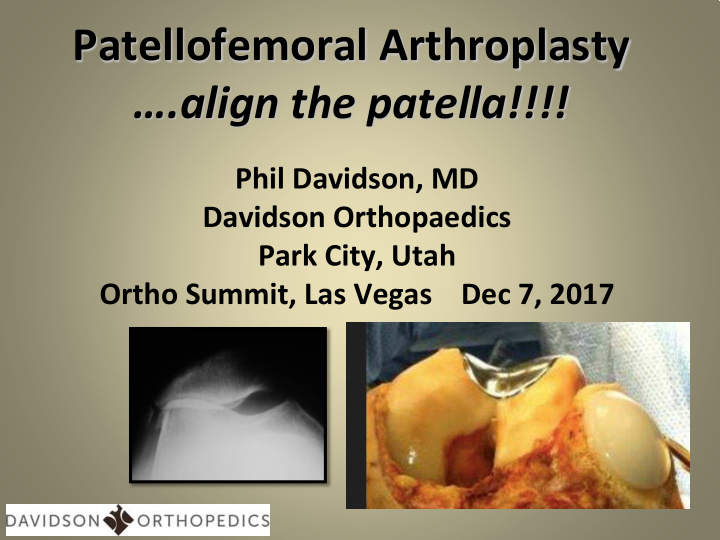



Patellofemoral Arthroplasty ….align the patella!!!! Phil Davidson, MD Davidson Orthopaedics Park City, Utah Ortho Summit, Las Vegas Dec 7, 2017
Disclosures none
Outline • Morphology • Geometry • Bio vs Prosthetic • Prosthetics/Implants • Realign Procedures • Combo Procedures – Realignment – Arthroplasty
The majority of PF DJD in isolation or in “younger patients” are associated with: 1. Abnormal Morphology 2. Abnormal Geometry Rotation Height Version 28 year old female
Morphology • Both patellar and trochlear morphology need to be identified in considering Wiberg Classification treatment options • Abnormal morphology can create stresses on repairs • May not make sense to do inlay resurfacing on abnormal morphologic topography Dejour Classification
Geometry • Geometric alignment needs to be considered in 3-D – Patellar position M-L • Valgus knee – Patellar “tilt” • Femoral version – Patellar height • Correction targeted at specific malalignment/rotation • NEVER do Lateral Release alone
Limb Rotation – femur and tibia • Both Femoral Version AND Tibial Torsion bear on PF forces • Femoral Anteversion – NL female 13 • External Tibial Torsion – NL female 27
Radiography Merchant Xray- need dedicated > 145 board/ jig considered “shallow”
Radiography- Patellar Height • Caton-Deschamps (CD) Ratio (X/Y) • NL appx 0.6-1.3 • Very handy to use digital measuring tools • Patellar Alta and Baja – Can be addressed with TTO – Alta possible MPFL
Radiography- TT-TG or TT-PCL Relative Patellar Translation • TT-TG, useful if distinct FTG sulcus – NL <appx 18mm • TT-PCL, may be more accurate, needed for abnormal FTG morphology – NL appx <24
Extensor Realignment • Medial Plication • Lateral Release • Need “normal” tissue to plicate – i.e. not markedly lax • Easily incorporated into PFA “Selective” lateral release, preserving underlying synovial layer– part of realignm ent, not alone!
MPFL combo with PFA • This is indicated when DJD coexists with recurrent instability and/or laxity • Need to protect patellar implant • Avoid patellar bone tunnel techniques
TTO with PFA • Medialization can correct for increased TT-TG or TT-PCL • Move proximal to address patellar baja • Distalize to address patellar alta
Biologic or Prosthetic Resurfacing ???? Key decision making point • Multifactoral decision – Lesion: focal or diffuse – Patient Factors – Comorbidities – Osteophytes – Bipolar – Resources Available Inverted patella of 19 yr old male
Radiographic Guide to Bio vs. Prosthetic Kellgren-Lawrence Grading Scale Generally Biological Resurfacing…… Grade 0 = Normal Grade 1 = Doubtful narrowing of the joint space and possible osteophytic lipping Grade 2 = Definite osteophytes, definite narrowing of the joint space KL 1 Generally Prosthetic Resurfacing….. Grade 3 = Moderate multiple osteophytes, definite narrowing of joints space, some sclerosis and possible deformity of bone contour Grade 4 = large osteophytes, marked narrowing of joint space, severe sclerosis and definite deformity of bone contour. KL 4
Biological Options • Scaffolds • Cell Therapy • Osteochondral Grafts – Autogenous • Limited use – Allograft • Fresh stored • Cryopreserved • Cartilage Grafts – Minced, ground, lamellar – Cryopreserved – Non-viable (scaffold)
Inlay vs Onlay Patella – Biologic
What if biologics will not or cannot work? …Transitioning the algorithm from biologics to prosthetics Prosthetics - Joint Resurfacing
Onlay vs Inlay Joint Resurfacing - Patella • Inlay useful for focal defects and for “normal” morphology • Onlay needed for diffuse chondral disease or “abnormal” morphology • I use Onlay MUCH more frequently
Onlay vs Inlay Joint Resurfacing for FTG • Onlay device replaces anatomy, but may add unwanted volume Onlay • Inlay device based on ambient anatomy • Inlay device allows for concurrent realignment • Inlay device inherently stable • Inlay typically more anatomic I nlay
PFA “legacy onlay implants” very negative history • Non-anatomical • Overstuffed the joint • Encroach on TF joint • Very mixed, negative results with high revision rates • Did not allow for concurrent alignment!!
Patellar-Trochlea alignment Key step- Patella directly over FTG
Summary • Must establish alignment • Want to accommodate potential revision to TKA • Cannot have plastic on cartilage (no poly patella alone) • Resurfacing must be done in context of anatomy/deformities • No Overstuffing
Thank You phildavidsonmd@gmail.com
Recommend
More recommend